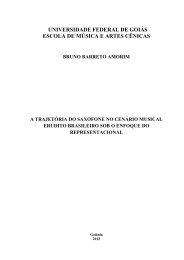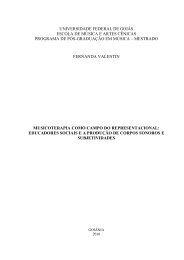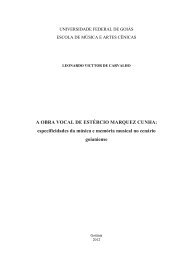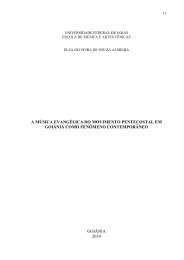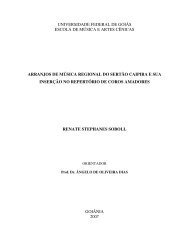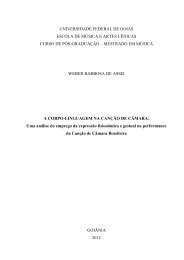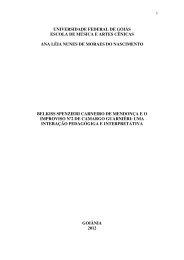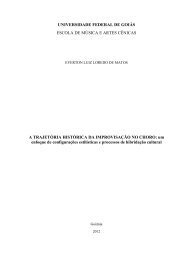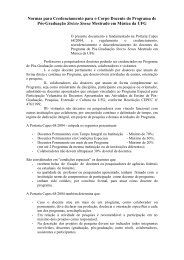Download - Mestrado em Música e Artes Cênicas - UFG
Download - Mestrado em Música e Artes Cênicas - UFG
Download - Mestrado em Música e Artes Cênicas - UFG
You also want an ePaper? Increase the reach of your titles
YUMPU automatically turns print PDFs into web optimized ePapers that Google loves.
Structural Overview<br />
Estudo I contains a large number of extended techniques in a single work. In addition,<br />
form and sequential harmonic patterns are intentionally de<strong>em</strong>phasized to provide an open ground<br />
for extended techniques. Nonetheless, the piece does contain a musical structure, as outlined in<br />
Table 1.1.<br />
Table 1.1: Estudo I: structural overview<br />
Introduction<br />
1 st<br />
Stat<strong>em</strong>ent<br />
2 nd<br />
Stat<strong>em</strong>ent<br />
3 rd<br />
Stat<strong>em</strong>ent<br />
4 th Stat<strong>em</strong>ent<br />
Extended Techniques<br />
Coda<br />
mm.<br />
1-8<br />
mm.<br />
9-18<br />
mm.<br />
19-29<br />
mm.<br />
30-42<br />
Flutter<br />
Tongue<br />
mm.<br />
42<br />
Multiphonics<br />
mm.<br />
43-49<br />
Circular<br />
Breathing<br />
and<br />
Humming<br />
mm.<br />
50-58<br />
Flutter<br />
Tongue<br />
mm.<br />
59-60<br />
Double<br />
Staccato<br />
mm.<br />
62-64<br />
Acutissimo<br />
Register<br />
mm.<br />
65-69<br />
mm.<br />
70-80<br />
The introduction is announced by a rapid and irregular arpeggio passage, in an ascending<br />
sequence from the lowest note E3 to a very high G#6, underlined by an ff dynamic. This<br />
arpeggio (E, G, G# and C) is repeated three times until reaching the altissimo register (G#6).<br />
It is followed by a sequence of descending eighth-notes, using an augmentation procedure that<br />
gradually slows the t<strong>em</strong>po, thus changing the character of the passage. When relating this pattern<br />
to post-tonal principles, one finds the numeric segment [0148]. Also, a flat-7 partial is obtained<br />
when the player reaches high G#6. The actual pitch should be an A6, as the harmonic<br />
series is [B, B, F#, B, D#, F#, A]. However, due to both its acoustical peculiarities and the unique<br />
construction of the instrument, the partial is so flat that an almost-perfect Ab is produced.<br />
Brymer asserts that “it is perhaps extr<strong>em</strong>ely fortunate that this flatness so accurately places the<br />
note ... because in fact it is the only one obtainable on most clarinets” (Brymer, 1992). Two hexachords<br />
(0,1,3,5,6,9) and (0,1,3,6,7,9), in measures three and five, respectively, have interval<br />
vectors and . This is a descending line, progressing from small intervals<br />
to wide ones.<br />
Example 1.1: Estudo I, mm. 1-8.<br />
Major and minor seconds and their inversions, and augmented and diminished fourths and<br />
fifths are combined randomly. The contour of the melody is sometimes <strong>em</strong>phatic and other times<br />
it is delicate. The effect created depends on each individual, according to his or her own t<strong>em</strong>perament<br />
and state of mind.<br />
A transitional section follows. This section is rather energetic, with a piú mosso marking<br />
and a ff dynamic. Descending and ascending mixed scales, basically in a whole-tone mode, also<br />
56<br />
Anais do XII S<strong>em</strong>p<strong>em</strong>



